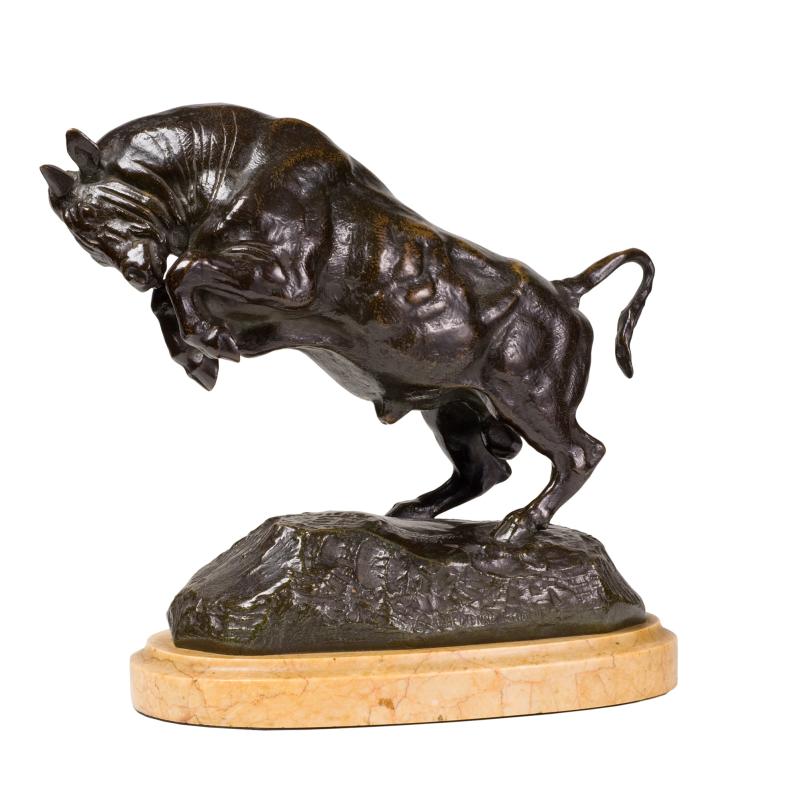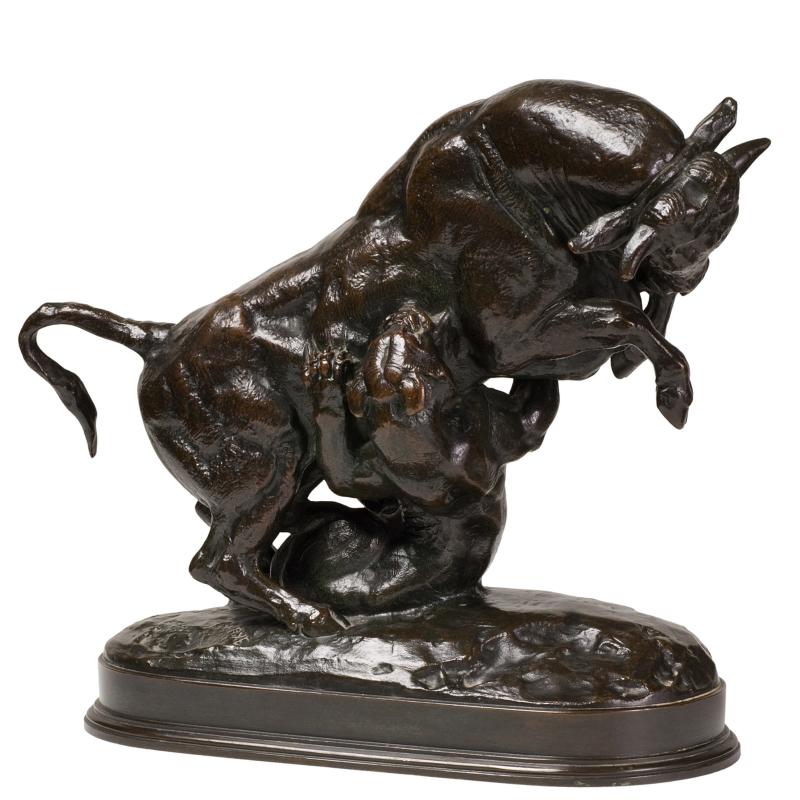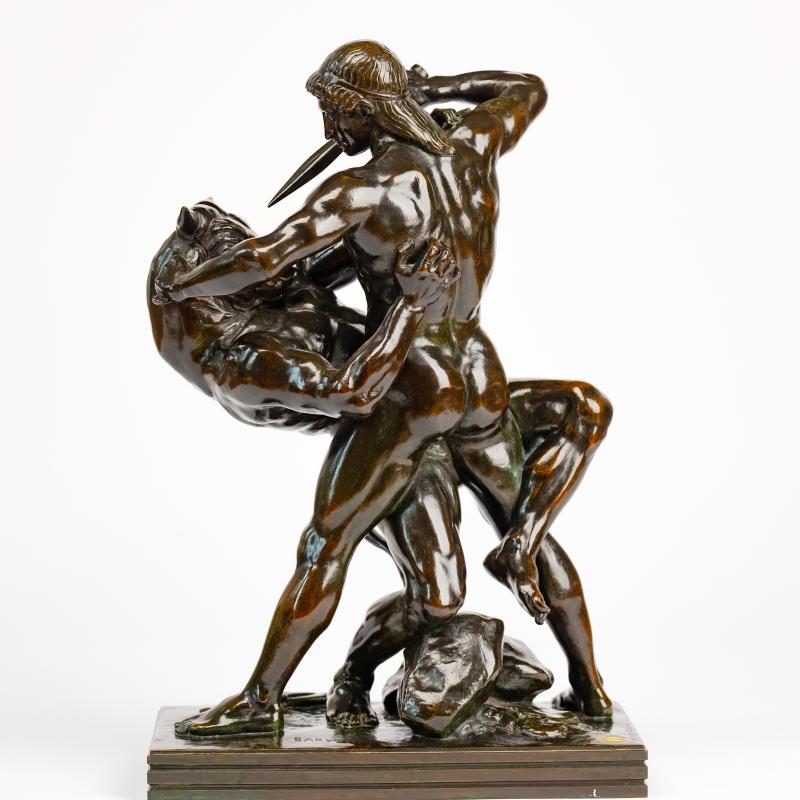-
 Antoine-Louis BaryeTaureau Cabre (Rearing Bull), modeled 1841; cast date unknownBronze9 1/2 x 5 1/4 x 10 3/8 inchesSigned: “BARYE” top edge of self-base
Antoine-Louis BaryeTaureau Cabre (Rearing Bull), modeled 1841; cast date unknownBronze9 1/2 x 5 1/4 x 10 3/8 inchesSigned: “BARYE” top edge of self-base
Marked: F. BARBEDIENNE FONDEUR
Inscribed: BERTHONVAL 1891
-
 Antoine-Louis BaryeTaureau Attaque par un Tigre, Modeled 1841-44Bronze8 1/2 x 10 1/4 x 4 inchesSigned: BARYE (top of self-base),
Antoine-Louis BaryeTaureau Attaque par un Tigre, Modeled 1841-44Bronze8 1/2 x 10 1/4 x 4 inchesSigned: BARYE (top of self-base),
Marked: F. BARBEDIENNE. FONDUER. (rear of self-base) and 125 and 9512 (ink, under)
-
 Antoine-Louis BaryeTheseus Slaying the Minotaur, 1843Bronze17 3/4 x 11 3/4 x 7 inchesSigned: Barye (top of self-base), Marked: Collection F. Barbedienne France (gold embossed seal, top of self-base) F. Barbedienne Foundry (top of self-base)
Antoine-Louis BaryeTheseus Slaying the Minotaur, 1843Bronze17 3/4 x 11 3/4 x 7 inchesSigned: Barye (top of self-base), Marked: Collection F. Barbedienne France (gold embossed seal, top of self-base) F. Barbedienne Foundry (top of self-base)
Overview
Antoine-Louis Barye is considered the “Father of the French Animalier School” that became popular in the middle of the nineteenth century. The Animalier movement was notable for its realistic and naturalistic portrayal of animals. Barye addressed themes such as wild animals in dramatic action pitted against each other in the struggle for survival. He was also instrumental in foundry practices and placed a great deal of energy and passion into the fabrication of his bronzes. Barye was extremely influential to generations of European and American sculptors. He received many commissions. He also executed many public works and monuments around France. His works are represented in the great museums throughout the world, with large collections in American institutions such as the Metropolitan Museum of Art, N.Y.; the Brooklyn Museum; the Walters Art Museum, Baltimore; the Baltimore Museum of Art; and the Corcoran Gallery of Art, Washington D.C.
Barye’s chief patron from the 1860’s on was W.T. Walters of Baltimore, whose collection is now the Walters Art Gallery, and who saw to it that Barye produced 120 works for the Corcoran Gallery in Washington the year before Barye died. Other American collectors were Cyrus J. Lawrence, James F. Sutton, Samuel P. Avery, Richard M. Hunt, George A. Lucas and Theodore Roosevelt. These nineteenth-century enthusiasts and their heirs so enriched our American public collections that they now hold more works of Barye than any other sculptor.
Exhibitions
Salon 1819 (2nd Prize), 1832, 1851
Exposition Universelle, 1855 (Grand Medal), 1867 (Grand Medal)
Museums and Public Collections
Aquarelles Museum, France
Art Institute of Chicago
Baltimore Museum of Art, Maryland
Bayonne Museum, France
Bordeaux Museum, France
Brooklyn Museum, New York
Chazen Museum of Art at the University of Wisconsin
Chi-Mei Museum, Taiwan
Clark Institute, Williamstown, Massachusetts
Cleveland Museum of Art, Ohio
Corcoran Gallery, Washington, D.C.
Courtauld Institute of Art, London, UK
Dahesh Museum, New York City
Detroit Institute of Arts, Michigan
Dublin City Gallery, Ireland
Fine Arts Museums of San Francisco
Harvard University Art Museums, Cambridge, Massachusetts
Hermitage Museum, St. Petersburg, Russia
High Museum of Art, Atlanta, Georgia
Hirshhorn Museum and Sculpture Garden, Washington, D.C.
Indianapolis Museum of Art, Indiana
Joslyn Art Museum, Omaha, Nebraska
Le Puy Museum, France
London National Gallery, London, England
Los Angeles County Museum, California
Louvre Museum, Paris, France
Maryland State Archives
Metropolitan Museum of Art, New York
Minneapolis Institute of Arts, Minnesota
Museé dâOrsay, Paris
Museé Magnin, Dijon, France
Museum of Fine Arts, Boston
National Gallery, London
National Gallery of Art, Washington, D.C.
National Gallery of Australia, Canberra
National Gallery of Denmark, Copenhagen
National Gallery of Victoria, Australia
National Museum of Wildlife Art, Jackson Hole, Wyoming
New Carlsberg Glyptotek, Copenhagen
North Carolina Museum of Art, Raleigh
Philadelphia Museum of Art, Pennsylvania
Princeton University Art Museum, New Jersey
Rouen Museum, France
Smithsonian American Art Museum, Washington, D.C.
Tacoma Art Museum, Washington
Tuilleries Gardens
Walters Art Museum, Baltimore, Maryland